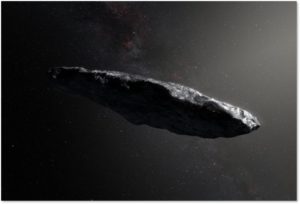Okay, I’ll admit it. I thought we were being showered by pieces of Alderaan after the Death Star blew it up. There had to be some reason, after all, why we were receiving so many alerts about asteroid close calls and near misses shooting through the solar system.
- “City Killer Asteroid Just Missed Earth” — Washington Post, July 2019
- “Huge Asteroid That Narrowly Missed Earth ‘Slipped Through the Net’ NASA Email Reveals” — Independent, September 2019
- “Asteroid warning: NASA tracks a 21,300 mph asteroid on a possible collision course in 2020” – Express, December 2019
- “Four Times Huge Asteroids Came Frighteningly Close to Earth” — Interesting Engineering, January 2020
They had to have come from somewhere closer than a galaxy far, far away..
Close Calls and Near Misses
Often, astronomers get a warning just a few days before something big enough to take out a whole city comes close to Earth. Sometimes we only learn about the near miss after the asteroid has passed by.
Granted, “near miss” in this situation often means a few million miles, but that’s not the point. Sometimes, they come closer. In 2017, an asteroid blasted past the Earth at 21,500 miles per hour on a trajectory that is closer to the planet than the moon. The closest approach came in 2011, when Near-Earth Object ES4 came within 121,299 kilometers, or 75,372 miles from Earth.
What if one comes closer than that? We have no distant early warning system for asteroid strikes. And, even if we did, all it could do is alert us to imminent destruction because we have no system for diverting a planet-killer. While the countries of Planet Earth are busy fighting one another and polluting our only home, we have paid no attention to defending ourselves from giant space rocks.
The Solar System’s Asteroids
Want to see how ginormous the asteroids inside the solar system are? Take a look at Bored Panda’s comparisons of asteroids with people, ordinary objects, buildings, the city of Manhattan and Planet Earth. Be sure to watch the video. It’s pretty darn scary. Even one of the smaller ones could devastate civilization with a tsunami, by atomizing a whole city, or by throwing enough dust into the atmosphere to create a nuclear winter.
But wait, there’s more.
Interstellar Objects
Not all asteroids come from inside the solar system. In July of 2019, the interstellar object dubbed Oumuamua (Hawaiian for advance scout) entered earth’s solar system from way outside it, possibly from one of four “nearby” dwarf stars. We know this because it was traveling at an incredible speed and entered the solar system at an odd angle.
Because space is huge, Oumuamua probably left its system of origin between one and seven million years ago, during planetary formation. When did we learn about it? Just a few days before it passed us by. As Scientific American wrote, “By the time we realized it, the guest was already out the door with its image fading into the dark street.”
I find none of this reassuring.
We Don’t Know What We Don’t Know
Here we sit, rotating on our axis, revolving around the sun, and rocketing through space, all at the same time. Out there fly giant rocks, looping around and through the orbits of our planets and their moons, occasionally playing chicken with the third rock from the sun.
Sometimes, they hit something. We know this from craters on Earth, Mars and the Moon. Those are just the ones that hit land: we have no idea how many have struck Earth’s oceans.
We don’t know when that’s going to happen, where the asteroids are coming from now, where they might come from next, whether they are going to hit the earth or skim on past. Donald Rumsfeld would call this the “known unknown.”
We seem to be comfortable, and even complacent, with this lack of forewarning. Editors write headlines joking about “guess who’s coming to dinner.” The consequences of an asteroid strike on a heavily populated planet are no joke, though. Extinction-level events never are.
Asteroid Size Matters
Know this: asteroids don’t have to be particularly large to do a whole lot of damage. The meteorite that exploded over the Russian city of Chelyabinsk in 2013 was only about 65 feet wide but it injured 1,200 people and damaged thousands of people.
A meteorite the size of a city bus could take out all of lower Manhattan. As Business Insider points out: “The Chicxulub asteroid that wiped out the dinosaurs is estimated to have been about 6 miles in diameter. That may sound like a pretty big space rock, but relative to Earth it’s pretty tiny.” To the dinosaurs, it was the end.
The Cost of Survival
But wait. Wouldn’t a DEW Line for asteroid strikes cost a lot of money?
Sure, it would, but consider these facts. The 18 years of war in Afghanistan have cost the U.S. $18 trillion. We spent another $2 trillion on the seven-year war in Iraq. You can buy a lot of advanced astronomical technology for $20 trillion.
And that’s just us. A world-wide effort to develop an early-warning system for asteroid strikes could tap contributions from other first-world countries. By contrast, NASA’s Apollo program cost $25.4 billion—which amounts to $152 billion in today’s dollars. That’s pretty cheap when it comes to knowing what’s flying at us from out of the void.
What Can We Do About It?
Which brings me to the question of how we would divert an oncoming asteroid. (Destroying it would just create a lot of smaller asteroids that could hit Earth in a scatter-shot way. Like the difference between a rifle bullet and shotgun pellets.)
Do we know how? Probably not.
We Don’t Have the Technology
I’m sure, however, that the military-industrial complex currently earning billions in taxpayer dollars to create weapons of destruction could turn their attention to saving the world. As long as they make big profits, what do they care whether their products kill people or save them?
Is anyone even talking about this? Nah.
In 2016, Space.com reported that “Space Scientists Rally Support for 2020 Asteroid Deflection System.” Now that it’s 2020, have you heard anything about such a system? Nope, crickets.
I think people just aren’t scared enough to prioritize saving the world from an asteroid strike. The problem is, however, that we might not get that heads-up warning before it’s lights out.






